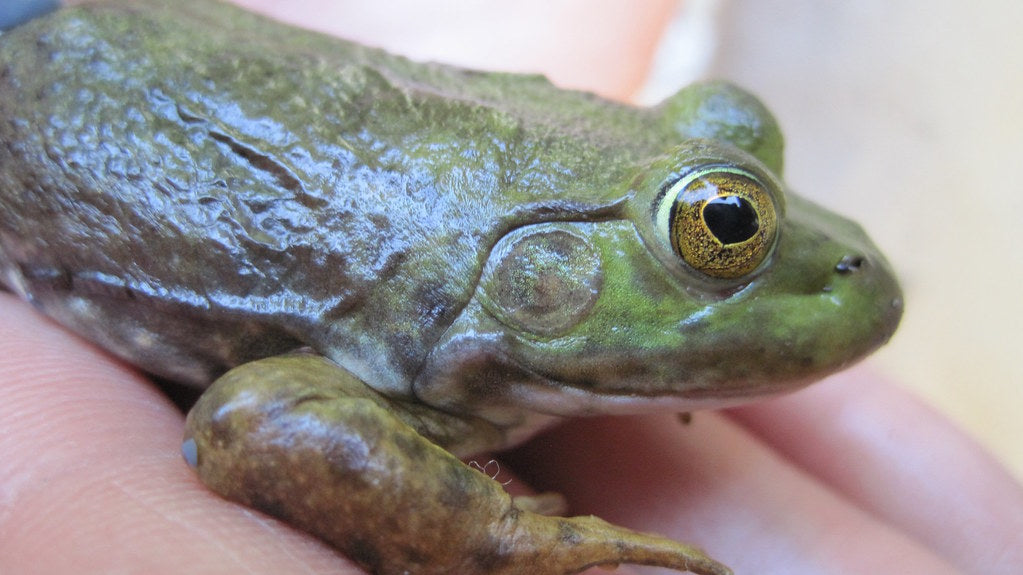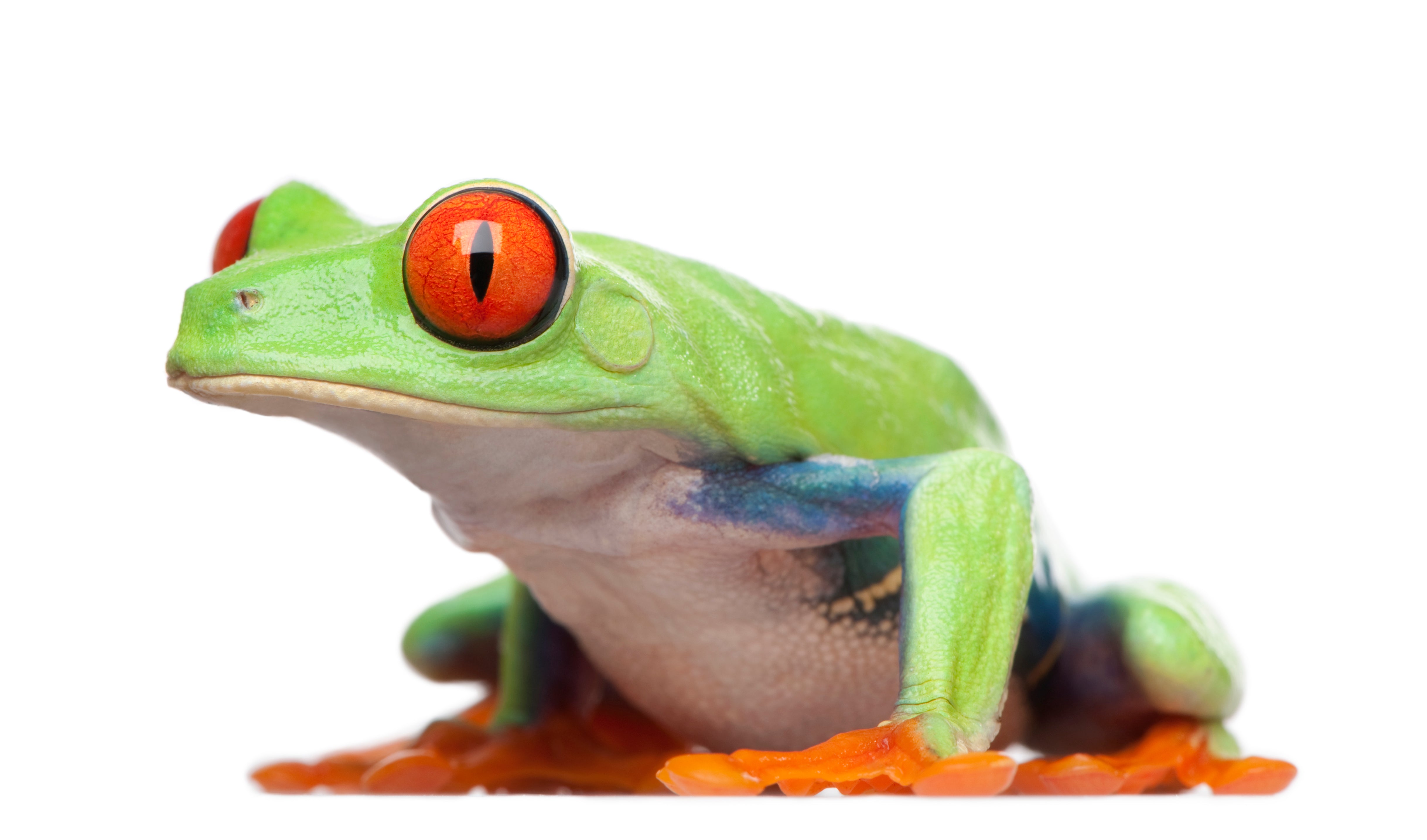The American bullfrog (Lithobates catesbeianus) is a large, semi-aquatic, diurnal species of frog. They are native to eastern North America, but are highly invasive and have spread to the southern and western US, as well as parts of South America, Europe, and Asia. They are highly adaptable, but they do best in habitats with warm, shallow water and plentiful aquatic vegetation.
American bullfrogs are among the largest frogs in the world, and are typically 3.5” to 6” long from snout to vent. They have large heads, muscular bodies, short front legs, long hind legs, and webbing only on the hind feet. They typically have an olive-green base color, and may have an overlaid pattern of gray-brown mottling or banding. The belly is pale and often blotched with yellow or gray.
Due to their semi-aquatic nature, large size, and sensitivity to poor husbandry, American bullfrogs are advanced-level pet amphibians. However, with good care, they can live up to 16 years.
American bullfrogs are very common in the US, but they often get dumped by keepers who don’t want them anymore. If you are considering a pet bullfrog, please consider adopting one from a rescue or your local classifieds. Never capture wild bullfrogs to keep as a pet!
How much space do American bullfrogs need?
American bullfrogs are large and active, so they need an enclosure that will appropriately accommodate these needs. The minimum for appropriately keeping one adult American bullfrog is 48”L x 18”W x 21”H, or 75 gallons. This is just the minimum, so using larger dimensions is beneficial and will happily be used! However, smaller can be used while they are a tadpole.
Cohabitation (keeping multiple bullfrogs in one enclosure) is not recommended, as this species is naturally solitary and well known for cannibalism.
Do American bullfrogs need UVB?
They seem to be able to survive without it, but it’s still best practice to provide UVB lighting for optimal health and wellbeing. American bullfrogs are active during the day and night, which means that it’s very likely they’re naturally exposed to sunlight on a regular basis. Providing UVB lighting to your frog gives them all of the vitamin D that their body needs, stimulates better appetite and activity, and generally allows them to be healthier than they would be without.
The best UVB bulbs for American bullfrogs housed in a 48” x 18” x 21” enclosure are:
- Zoo Med Reptisun T5 HO 5.0, 22”
- Arcadia Forest 6%, 22”
The UVB bulb should be housed in a reflective fixture like the Arcadia ProT5 or Vivarium Electronics, and placed close to the heat lamp, about 13-15” above the basking platform if over mesh, and 16-18” above the basking platform if not. UVB is blocked by glass and plastic, so you can’t give your frog UVB by placing its terrarium in front of an open window. Also make sure that the fixture your UVB bulb is in does not have a clear plastic bulb cover. UVB bulbs decay over time, so don’t forget to replace your bulb every 12 months to maintain good performance.
Lights should be on for 12 hours/day.
What basking temperatures do American bullfrogs need?
American bullfrogs are ectotherms, which means that they rely on the temperature of their environment to help regulate their metabolism and stay healthy.
The warm side of the enclosure should stay between 80-84°F, and on the other side of the enclosure, the temperature should be around 74°F. Measure air temperatures in these locations with digital probe thermometers, with the probe placed in the desired area. A temp gun can also be helpful.
A good way to warm the enclosure is with a couple of low-wattage heat lamps clustered on one side of the enclosure and positioned over a sturdy basking branch or rock. Do not use ceramic heat emitters (CHEs), red bulbs, or blue bulbs, as these are not as effective. Increase the wattage if it’s too cool, and use a plug-in lamp dimmer if it’s too warm.
What humidity levels do American bullfrogs need?
As amphibians, bullfrogs are very dependent on water — especially when they’re still just tadpoles! Average air humidity should stay around 60% during the day, as measured by a digital probe hygrometer. If needed, misting your frog’s enclosure daily with a sprayer will help create the right humidity levels.
American bullfrogs are semi-aquatic, which means that most of the enclosure should be water. This means that you will either need to place a large, removable tub of water inside the enclosure, or you will need to create a paludarium setup that functions like a shallow aquarium plus dry land.
If you go the water tub route, waste and debris will need to be removed daily, and the tub itself will need to be removed and scrubbed with animal-safe disinfectant once a week. The new water must be treated with dechlorinator before replacing — never used distilled or reverse-osmosis water for your frog!
If you turn the enclosure into a paludarium, you will need an appropriately-sized filter to keep the water clean, which requires specific routine maintenance of its own. Adding certain live aquatic plants can help maintain good water quality on top of the filter.
What substrate is good for American bullfrogs?
American bullfrogs require a thick layer of moisture-retentive substrate to cushion their bodies and help maintain healthy humidity levels. As an added perk, it also tends to make the enclosure more attractive.
For the land portion of the enclosure, this substrate should have small particles and hold moisture well. It should also be able to support plant life if you are using live plants:
For the aquatic portion of the enclosure, substrate is not required, but it can help make the enclosure more attractive. If you plan to plant live plants, you will need an aquatic substrate that supports plant growth:
- Fluorite
- Exo Terra Riverbed Sand
Remove poop and urates daily. If you are not using a bioactive paludarium setup, substrate should be replaced every 2 months to maintain good hygiene.
What décor can you use in an American bullfrog enclosure?
It’s terribly boring for a frog to be stuck in an enclosure with nothing in it except land and water. It doesn’t matter how big the enclosure is if you don’t put things in it for your pet to use and interact with.
Décor options for bullfrogs include:
- mopani wood
- cork bark
- rocks
- live or artificial plants
- pre-made hides/caves
Whatever you choose to use, make sure that the frog has cover to hide in so it can feel secure in its environment.
What do American bullfrogs eat?
American bullfrogs are primarily carnivores, which means that they need to eat whole animal prey in order to get the nutrition that they need. Tadpoles and young bullfrogs should be fed daily, but adults should be fed 2-3x/week to prevent obesity.
Despite the fact that they are carnivorous as adults, American bullfrog tadpoles are actually herbivorous, eating algae and other aquatic plant material.
Adult American bullfrogs are well known for their voracious diet, and will eat just about anything they can fit in their mouth. However, they prefer live prey to pre-killed, as they are attracted to movement.
Food options for American bullfrogs:
- Black soldier fly larvae
- Crawdads
- Crickets
- Discoid roaches
- Dubia roaches
- Earthworms
- Fish
- Hornworms
- Mealworms
- Mice
- Shrimp, whole
- Silkworms
- Snails (captive-bred only)
- Superworms
(Smaller bullfrogs are more likely to eat insects than larger bullfrogs.)
Supplements
Bullfrogs need vitamin and mineral supplements to enjoy optimal health. We recommend Repashy Calcium Plus LoD, lightly dusted on their prey at each feeding. Occasionally skipping a dusting is fine.
Do American bullfrogs like to be handled?
Few reptiles actually “like” to be held, and American bullfrogs are not one of them. If you want to bond with your pet, try feeding them from soft-tipped feeding tongs rather than using your fingers, as these frogs have a powerful bite!
Handling should be kept to a minimum, but when you have to grab your frog, wear a pair of nitrile gloves, use a net, and gently grasp the frog behind the head with one hand while restraining the rear legs with the other hand.
*This care sheet contains only very basic information. Although it’s a good introduction, please do further research with high-quality sources to obtain additional information on caring for this species.
"American Bullfrog" by U.S. Geological Survey is marked with CC PDM 1.0



Leave a comment
This site is protected by hCaptcha and the hCaptcha Privacy Policy and Terms of Service apply.